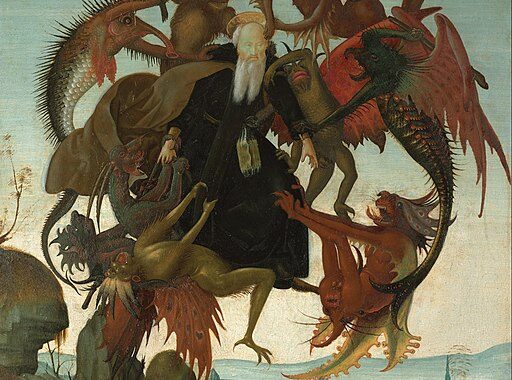The scandals and sins of our modern age seem so, well, modern, that we might be tempted to think that the examples of people from past ages cannot help us. After all, how would the people who lived millennia ago been able to help us find solutions to problems like sexual promiscuity, consumerism, and mockery of all things Christian?
The saint celebrated by the Church on January 17, Saint Anthony the Great, could.

Public domain, via Wikimedia Commons
Anthony was born in Egypt in the year 251. Although Christianity was illegal in the Roman empire at the time, the persecution of Christians waxed and waned from time and place, so his wealthy Christian parents were able to safely raise him and his sister in the faith. When they died, Anthony was only a young man, although a very rich young man. Inspired by a few passages of the Gospels that were read at Mass and that God seemed to directly focus on him, he left everything behind to live in the desert. During the rest of his long life—he died at the age of 105—Anthony lived in extreme poverty, trained the Christian men who chose to follow him how to live lives of holy asceticism, fought demons, corresponded with emperors, survived possible martyrdom, converted crowds, performed miracles, and, to keep his hands busy, wove mats.
The image above, painted by a young Michelangelo many centuries after Anthony’s death, portrays one of the most famous stories of his life. As recounted by Saint Athanasius of Alexandria in his famous biography, Anthony soon learned that living in the desert was a true battle. Athanasius had already fought some famous battles with the Roman emperor when he, as bishop of Alexandria, refused to mouth the lies about Jesus Christ which are now known as the heresy of Arianism.
But the battles that Anthony faced as a young man were the same kind of battles faced by every young man and woman who has ever lived: the battles for purity and temperance. Just because Anthony lived in the desert, far away from elegant food, physical comforts, and lovely women, that didn’t mean the thoughts of them weren’t continually tempting him to run back to his former home. Anthony experienced these memories and imaginations as demons who continually taunted and tested him. Though Anthony had few visitors, even they reported that they could somehow see this battle occurring between Anthony and the devil. Obviously, Anthony ultimately won that battle and became a saint.
When Anthony was nearing the end of his life, the persecution of Christians erupted again in Egypt. Dressed in a sheepskin tunic—presumably a sign not only of his poverty but of the fact that he was a Christian monk—he entered the city to encourage the Christians living there to stand fast in their faith. Even the pagans were impressed with this amazing man from the desert. Why? Not only because his prayers resulted in miraculous healings in their midst or because of his great age. But because, having sought Jesus Christ for so long in silence, he was able to show even unbelievers the characteristics of God through his respectfulness, intelligence, charity, simplicity, and truth.
How did Anthony defeat the perennial human desire for sexual gratification, an unending yearning for more and more stuff, and the cowardice that leads us to abandon what we believe in when it threatens our comfort or even our life?

Melkite Greek Catholic Archeparchy of Beirut and Byblos,
Public domain, via Wikimedia Commons
The answer is shown in the tiny cross in Anthony’s hand in the Lebanese icon shown above. It is only the Cross of Jesus Christ that can help us, as it helped Anthony, discipline our unruly passions, be at peace with what God gives us, and speak truthfully and charitably about our faith to those who mistreat us. The Cross of Jesus Christ is the weapon of love that allows His followers to be victorious in every time and place.
Saint Anthony, help me remember to turn to the Cross of Christ in fighting my own spiritual battles.
To learn about other saints celebrated by the Church during the month of January, see this blog about saintly teachers.


